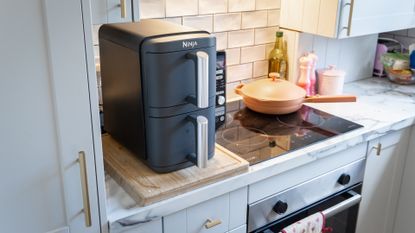Want one of the best air fryers but don’t have the space? This is where the Double Stack XL by Ninja comes in, thanks to its design that stacks two cooking compartments on top of each other. This layout reduces the fryer’s footprint, while still slotting beneath most kitchen cupboards and having the space to cook up to four foods at once, at two different temperatures.
All the usual air fryer benefits are present and correct – food is claimed to cook more quickly, using less oil and less electricity, while also being crispier, if that’s what you want. As well as the two compartments, each with their own stainless steel crisping rack for a total of four cooking areas, the Ninja Double Stack XL has six cooking functions. These include air fry, max crisp, roast, bake, dehydrate and reheat.
Is it the perfect air fryer for saving space yet still cooking up a feast? Read on to find out.
Ninja Double Stack XL Air Fryer review: Price and availability
At £269.99, the Ninja Double Stack isn’t the cheapest air fryer around. You can pick up a side-by-side, two-drawer model with a similar capacity for closer to £150. But those models, like the Ninja Foodi Dual Zone Digital air fryer, take up more worktop space.
Given the features of each are similar, the extra price of the Double Stack XL is only justifiable if you're tight on space. It’s not entirely clear why stacking the drawers significantly increases the price, but that’s what Ninja has decided.
The Ninja Double Stack XL Air Fryer is available to buy at Ninja and other select retailers like Amazon, Currys, Argos, Very and John Lewis.
Ninja Double Stack XL Air Fryer review: Unboxing and setup
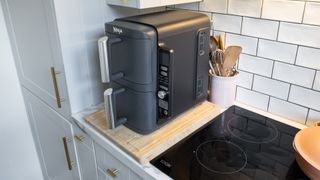
I must confess that, despite being a keen home cook, I am new to air frying. The craze had passed me by until now, not because I wasn’t interested, but because the small kitchen of our one-bed London flat simply doesn’t have the space.
The clever stacked design of this Ninja air fryer could change all that. Like other kitchen products, it comes in a large box and, at 10.3 kg, is quite heavy. The setup process takes just a few minutes, with the dishwasher-safe non-stick crisping plates slotting into the drawers, then the stainless steel racks sitting on top.
The dimensions are a crucial aspect of this air fryer – indeed, its size is the entire reason for buying this over a more conventional model with the drawers sat side-by-side. The Double Stack XL measures 38.5 cm tall, 28 cm wide and 47 cm deep. This means it should slot neatly under almost all kitchen cupboards, but since Ninja states 15 cm of clear space is needed in every direction, you might have to reposition the air fryer during use.
It also comes with a handy quick-start guide and recipe book that’s great for air fryer rookies like me. There are lists of food with preparation instructions, oil quantity (if needed at all), cooking temperature and time, all neatly laid out, plus around a dozen full recipes, complete with pictures, for cooking entire meals with the air fryer. It’s a comprehensive guide and, while a little intimidating at first – it feels a bit like you’re learning to cook all over again – I found it really helpful.
Ninja Double Stack XL Air Fryer review: Design and features
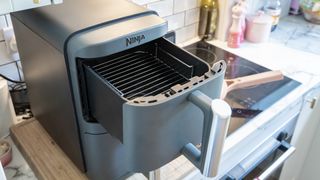
The design is the key element here. This air fryer has a compact footprint while boasting the capacity to cook eight different foods at once, and the two, 4.75-litre drawers can be set to different temperatures too. The control panel includes a time/temperature display for each drawer, a rotating control dial and buttons for setting everything up.
The interface isn’t the most intuitive, so you’ll likely need to refer to the instructions a couple of times until you get used to it, especially if you’re new to air frying. There’s more going on here than simply turning on the oven and putting your food in.
There are six different cooking modes to pick from, then the ‘dual zone technology’ panel, which has buttons for matching the two drawers, or setting them to different schedules. The clever thing here is, if you’re diligent with the programming, you can set the air fryer to run the drawers at two different temperatures, for two different times, but finish together, so all your food is ready at once. There’s a chart in the instructions to explain this further, along with how to cook two items in the same drawer, such as salmon fillets on the crisper plates above some asparagus, or a steak above potatoes.
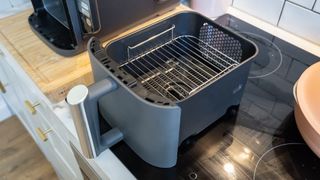
I found the Double Stack XL fairly easy to clean. The drawers come out, of course, then it’s just a case of lifting out the stainless steel racks and non-stick plates, and giving them a clean. They’re all dishwasher safe, but it’s equally easy to wash them up by hand.
I do have a couple of criticisms, however. Because this air fryer heats from the back instead of the top, the rear of each drawer is perforated to allow hot air to come in; this means oil and small bits of food can fall out when you give the drawers a shake mid-cook – which is something you’ll need to do fairly frequently, as I’ll explain later.
Secondly, the drawer handles have small holes in them, so fill up with water when submerged in the sink. This water will spill out when you’re drying them, which is a bit annoying. Since the holes are on the bottom of the handles, you’ll likely find a puddle below the air fryer when you put the freshly-washed drawers back in. I also found the stainless steel racks are tricky to pick up and handle with oven gloves, and the way they sit in the drawers means it’s possible for them to fall through at an angle, causing your food to spill onto the lower half of the drawer. A less fool-proof way of attaching the racks to the drawers would be welcome.
Lastly for the design – and as with all air fryers – is how different worktop materials are affected by heat. Since we have a laminate surface that isn’t heatproof, I sat the air fryer on a thick wooden chopping board. More durable surfaces like granite, quartz and concrete are less likely to suffer heat damage, but it’s best to check with your kitchen fitter, or put the air fryer on a silicone heat mat, a trivet or a chopping board to be on the safe side.
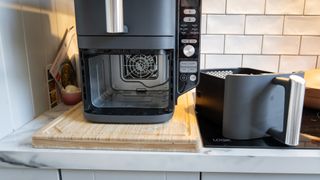
Ninja Double Stack XL Air Fryer review: Performance

I went into this review uncertain about how the Double Stack XL would perform. Other reviews, especially on YouTube, criticise this air fryer for not cooking food evenly, and demonstrate how food at the front of each drawer cooks much more quickly than that at the rear.
But, while I noticed some unevenness, as shown with the partially-cooked croquettes pictured above, this is easily solved by shaking or rotating food a couple of times during the cooking process. I cooked a wide range of food in this air fryer, including chips, croquettes, padron peppers, cubed potato for patatas bravas, and some breaded chicken tenders. I also used it to reheat a shop-bought Spanish omelette as part of a tapas night.
The homemade chips showed signs of uneven cooking after the first few minutes, but a quick shake to rearrange them in the drawer solved this. You can see a photo of them after cooking below.
I understand that some air fryer owners will want to put their food in, set the temperature and walk away, and for that the design of this model might not be ideal. But since the air fryer cooks so quickly – chips take about 24 minutes – it’s not like you’re going to sneak an episode of television in before they’re ready.
Given this air fryer can cook four different foods at once, it’s likely you’re a hands-on chef who tends to keep busy in the kitchen. A quick check on the food, and a shake to rearrange if needed, feels like a small price to pay. Do that, as I did, and the results are top-notch. I was especially impressed by the crispiness of our homemade croquettes, pictured above, which wouldn’t normally be possible in a regular oven.
As you can see in that photo, they cooked a little unevenly. I swapped them around after taking this photo, put them back in, and when finished they were all cooked evenly.
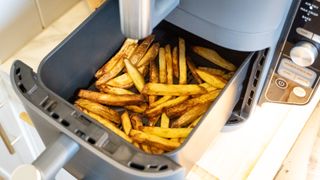
The lack of oil is also a benefit of air frying, as I’m sure you know. Homemade chips need just a tablespoon or two, as per Ninja’s included recipe booklet, while oven chips need none at all. I was also impressed by how quickly food cooked, but that’s a positive of air fryers generally, not just this one. Lastly, I was impressed by how little heat leaked from one drawer to the other, meaning you can confidently cook at two different temperatures at once.
As for the negatives – and as I've already addressed explained – I encountered some unevenness between the front and rear of each basket, but it was nothing a quick shake or rearranging of food couldn’t fix. This takes away the set-it-and-forget-it nature of air frying, but I like to check in on my food as it cooks, so moving things around to ensure they cook evenly felt natural.
You’ll also need to plan carefully if you make use of all four cooking zones; we cooked tapas one night and had to think about what would be cooked where, when, for how long and at what temperature. The ‘Double Stack Pro’ system here can help, but only if your meals fit in with what’s described in the recipe booklet.
Since there’s essentially a pair of different cooking zones in each drawer, you’ll need to weigh up the pros and cons of each zone, then decide what food will benefit most from which, before you get started. That said, I loved being able to cook at two different temperatures at once, and pick either the lower tray or the higher crisping rack for each temperature. It’s a bit like moving things around on the grill of a barbecue to cook them differently, and means using this air fryer is a bit more hands-on than others.
Naturally, given the relatively small footprint you can’t cook larger items like pizzas. There’s plenty of room for a large steak or two piece of salmon on each rack, plus two portions of chips, potatoes or veg below. That means a potential total capacity of two, two-piece meals for two people.
Ninja Double Stack XL Air Fryer review: Verdict

The Ninja Double Stack is an air fryer with a very specific use case. If you don’t have much worktop space, but want an air fryer with two separate cooking compartments, this is what you’re looking for. What’s more, the included crisping racks mean you have four separate cooking zones, with each pair able to cook at different temperatures and for different times.
This adds complexity, but means more adventurous home cooks can experiment with air frying up to four different foods at once, with space for two portions of each. This certainly gives the Ninja Double Stack XL an edge over its rivals, but such freedom comes at a price. The air vents on the back of each drawer mean oil and crumbs can spill out when you, inevitably, have to give everything a bit of a shake to ensure it’s cooked evenly.
It’s true that the stacked design means food can cook less evenly than in a conventional air fryer, since the warm air is coming from behind instead of above. But top-down air fryers still ask that you turn food half-way through cooking, so the same logic applies here. Give your chips a shake, or swap larger items front-to-back a couple of times during cooking, and everything will cook evenly.
It probably won’t replace your oven. But for low-energy, low-oil cooking – or when you want to make sure your food is extra-crispy – in a kitchen with limited counter space, this air fryer is a great option.
